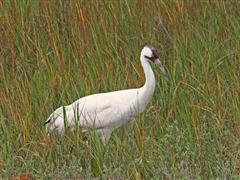Crane - Whooping
Scientific Name: Grus americana
Fri, 1st November, 2024 - 8:30 am GMT
Sponsor Ads:

Alternative Name
Scientific Name: Grus americanaBasic Info
N/A
Health
When kept in captivity, the large Whooping Crane needs a great deal of space. They should be fed a diet close to their natural diet of grains, amphibians, and invertebrates. Breeding Courtship is an elaborate procedure among Whooping Cranes, and involves flight, call, and dancing displays! Generally, Whooping Cranes build their nests of water vegetation like bulrushes or tufted marsh plants. These nests may be four feet in diameter! They usually lay two eggs, which will incubate for about 30 days. The young that hatch will fledge by the time they are about 85 days of age. Captive bred juveniles must be taught to migrate, as they may not breed in the wild without first undergoing this process. The Whooping Crane reaches sexual maturity when it is between three and five years of age.Habitat
N/ABehavior
The majestic Whooping Crane is one of the world's rarest cranes! These lovely birds made an incredible comeback after teetering on the verge of extinction; but if we do not continue to carefully conserve the birds and their habitat, they could easily continue to die off. Usually, Whooping Cranes winter in southern regions of North American and return to areas that are more northerly in summer. Populations living in warm or temperate climates, such as the birds in Florida, usually do not migrate. Usually, Whooping Cranes are found in wet prairie lands or coastal marshes.They do not swim, and have the peculiar habit of flying with their necks extended and legs dragging in the air behind them. Mating ends in late spring with procedures that betray the birds' restlessness to migrate. Whooping Cranes will dance for each other, call to each other, and engage in displays of flying! Although migration usually takes place in the day and lasts about three weeks, it can take longer. The birds stop at night to feed and rest, and sometimes may remain at a stopover for about a week! Although they live about 24 years in the wild, captive Whooping Cranes can live to between 35 and 40 years! These birds usually mate for life, but will often accept a new partner if their mate dies.Origin
North AmericaHistory
Although they once ranged over most of North America's eastern and central areas, Whooping Cranes' habitats were destroyed for agriculture and the birds themselves were extensively hunted for their plumage. Between 1940 and 1941, only 15 known Whooping Cranes remained alive! Canada and the United States began strict protection programs in 1916 for both the birds and their habitats, and captive breeding programs began. These efforts escalated as the birds became scarcer. Although they are still endangered, there were more than 200 Whooping Cranes living in the wild in 1996. Today, Whooping Cranes are still in danger. They have lost a great deal of genetic diversity, and their habitats continue to be polluted and lost to developers. They are used today to educate people worldwide about the importance of international cooperation in saving endangered species, and remain a compelling argument that if we care enough about wildlife, we can preserve it.Common Foods
In these wetlands, they find crustaceans, invertebrates, fish, amphibians, or snakes to eat. Whooping Cranes also eat vegetation like grains and wheat.Sponsor Ads:
"As he was valiant, I honour him; but, as he was ambitious, I slew him" . Act III, Sc. II, William Shakespeare
Crane - Whooping
Coded by: BGID® | ALL RIGHTS RESERVED Copyright © 2000-2024
Disclaimer | Privacy | Report Errors / Contact | Credits








 versus
versus  The role of its Army, Politics, and Status in the World.
The role of its Army, Politics, and Status in the World. 
 versus
versus 
 This Thread is about the North Korean Military itself - the kind of army, navy, and air force they have.
This Thread is about the North Korean Military itself - the kind of army, navy, and air force they have. 
 versus
versus  versus
versus 
 versus
versus  versus
versus